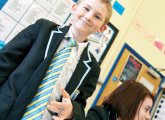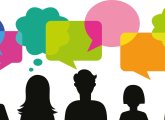My students are definitely used to me referring to ‘idea babies’; thoughts which have not been fully formed but which appear to offer potential and originality. When invited to ‘explore the imagination’ it is dangerously easy for anyone to fall into producing crass sketches of dragons and bad caricatures. It is easier, of course, to draw some literal skulls and then do a painting of one of these; but whilst that ticks various assessment objective boxes, it offers few leaps in imagination and resourcefulness. Students need opportunities to explore, play and grow confidence in the imagination as a tool. The process of developing thought into work is what it’s all about.
WHY TEACH THIS?
Giving students confidence in their imagination and their ability to explore the dynamism of merging observed and imagined imagery in sophisticated ways sets them up with amazing skills to continue to master throughout their education and beyond.
STARTER ACTIVITIES
Mapping the mind
This project can be broken down into smaller units. Each works independently, or as an entirety to cover the year. The starting point is for the students to produce the most amazing mind-map ever. This is essentially a window into their thoughts and ideas, reflecting on an initial teacher presentation. The projects which can then be covered include: collage and layering; photography and performance art; drawing and painting; and sculptural responses. Each can have a different subject matter such as ‘How do I perceive my reality?’ which could be very much about environment, places, spaces, physicality – explored in drawing or photography. Distortion could be another theme. This would allow for unusual viewpoints, distorted surfaces, reflections, aps which distort etc.
Perhaps suggest some starting points for the mind-map such as:
Literature, poetry and performance (“How cruel your veins are made of ice water and mine are boiling” E Bronte, Wuthering Heights) – Ideas, thoughts, reason, feelings (cf Arnulf Rainer and Cindy Sherman).
Collage – photo collage recording everything that you noticed today. Mood boards. Perception of spaces – for example, focusing on the shadows in a room or on the small pockets of light which pierce them; the window frame as a barrier, or the clouds beyond the window. Layering imagery together can allow for interesting visual conversations, as well as confusion, which can also inspire creativity. The process and evolution of these works is as much an end result as the physical outcome: the journey may in fact become the outcome itself. Photograms, selective exposure, working in a Dark Room, cut and paste, stitching imagery together, inverting, using carbon paper to superimpose, the possibilities are endless (cf Scott Hazard, Hannah Hoch, Henry Matisse, Kurt Schwitters, Kara Walker, Richard Hamilton, John Stezaker, Damien Blottiere, Matt Wisniewski, Melinda Gibson, Annegret Soltau).
Curating my thoughts: lists, journals, organisation, order vs chaos, collections (cf Joseph Cornell and Basquiat). ‘Don’t judge a book by its cover’ (cf Su Blackwell book sculptures).
Abstraction. Mindful painting and expressionism.
The process of thought (biology) on a cellular level. Cells viewed with a microscope. Metaphysics: energy into thought (cf Antony Gormley’s ‘Bed’ made out of 8,640 slices of Mother’s Pride). Psychology, mindfulness and mental health awareness: the focus being on how unique we all are. Fantasy and nightmares: letting the ideas out. These could include negative thoughts, thinking patterns and OCD.
MAIN ACTIVITIES
Next steps
I would work through the process following this pattern:
Literally ‘what is inside my head’: collect images, take photographs and sketch skulls (these do not need to be human). Discuss Marc Quinn’s head and do some research on it: how does it make you think and feel about your own creative processes and barriers?
Collect materials which can be used to develop collages. These can be photocopied multiple times to develop work such as the layered pieces Scott Hazard develops. Ideally work should be original so photographs are particularly useful and first hand sources are always better than images from google. I always tell my students that they should work from originals as much as possible, if for no other reason than to ensure originality. Appropriate where necessary.
Homework can include documenting a particular area of research e.g the sky, details of ruffled fabric, doorways and exits etc. These should be turned into dynamic mood boards and then worked into in a variety of ways, observing the work of contemporary collage artists listed previously.
Get into a computer lab with Photoshop or equivalent and teach the following processes:
1. Layering two or more images together using copy and paste. Then change the individual layers by reducing the opacity and exploring pre-sets.
2. Selecting an area such as a figure in a photograph and replacing it with different imagery as in the work of Melinda Gibson and Matt Wisniewski.
Students will need a few lessons in order to get some good results but this is a really useful tool for them to understand well for the future. They can generate multiple outcomes and if the original imagery they are working with is their own, every outcome is valuable. Even the most experimental. Risk taking should be encouraged.
If a Dark Room is available, students can also produce chemigrams and photograms which allow them to further explore both the process and their instinctive use of various materials to create imagery in the dark room. These might later be scanned and explored further in Photoshop, or may be used for traditional cut and paste processes.
Exploring ‘self’ in terms of words; thoughts, lists and collections can be a very interesting theme. The notion of ‘curating my thoughts’ in terms of organisation and expression can be very exciting. Look at artists such as Basquiat, or Blackwell if you are thinking about developing a book project, using books themselves as sculptural items. This not only links to literature, poetry, performance art and psychology, but also to themes of mental health and therefore PSHE. Links can be made and work could even be designed to be included in an exhibition about diversity and individuality.
Include lessons on mindfulness and think about artists who work in this way.
Finally I would complete this project with the option to paint or sculpt a response. A painting would evolve from the collage work and this would either be produced directly onto canvas/ paper, or it could be projected onto an unusual surface such as an old cupboard door.
Emulsioned white, this provides an interesting surface on which to work, also reflecting the nature of ideas being stored within, or a door as the way into or out of a place.
My students usually finish this project working in clay and developing busts around paper armatures (fixed to a rigid base). They initially develop the head shape, then add features and finally bring their own unique ideas to fruition, often sculpting quite macabre but highly moving pieces.
SUMMARY
If the process is recorded throughout with plenty of observations made, photographs and descriptions of processes, as well as research into the work of various artists, students will have covered everything in terms of examination assessment criteria. The project allows for a great deal of analysis, above and beyond description, which pushes them into a higher mark band. Analysis should include how and why imagery affects the viewer. The projects allow for huge leaps in imagination whilst exploring themes that sit nicely under one title. The exploration of self, and of thought, is essentially the making of art: it is the activity and the method and the theory. It is the essence of it all.
And, it is jolly good fun!
ABOUT OUR EXPERT
Emma Delpech teaches art at Sevenoaks School, Kent. A practising artist, she believes that imaginative use of materials, processes and techniques allows students to explore their creative potential in dynamic ways. emmadelpech.com









